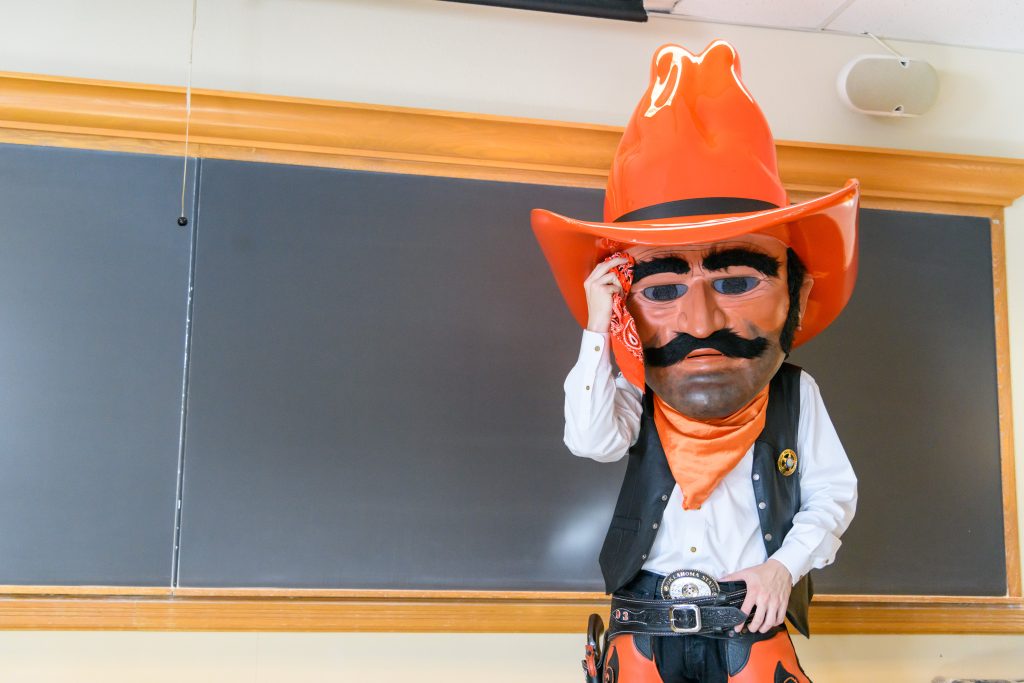2.1 What is Communication Apprehension?
Click below to play an audio file of this section of the chapter sponsored by the Women for OSU Partnering to Impact grant.
“The brave man is not he who does not feel afraid, but he who conquers that fear.” -Nelson Mandela
“I have to do what?”
You receive your syllabus on the first day of history class, and you see that a significant percentage of your overall grade for the semester depends upon one, ten-minute oral presentation in front of the class. The presentation is to be based on an original research project and is due in eight weeks.
You are excited to get an email after a very positive job interview. They ask you to come to a second interview prepared to answer a number of questions from a panel made up of senior management. The questions are contained in an attachment. “Please be ready to stand in the front of the room to answer,” the email reads; ending with “See you next week!”
The plans are finalized: You will have dinner to meet your new fiancé’s family on Saturday night – just days away. But, then you are told that your fiancé’s father, a former Marine and retired police officer, will want to talk about politics and current events – and that he will likely judge what sort of person you are based on how well you can defend your ideas.
In this chapter, you will learn about dealing with one of the most common fears in our society: the fear of public speaking. Fear of public speaking is associated with communication apprehension (CA), which is an individuals level of fear or anxiety associated with either real or anticipated communication with another person or persons (McCrosky, 1977). If you are one of those folks – take comfort in the fact that you are not alone! Research indicates that 20% or more of the U.S. population has a high degree of communicative apprehension (McCroskey, 1976).
CA is a real phenomenon that represents a well-documented obstacle not only to academic, but also to professional success. CA can impact many diverse areas; from one’s level of self-esteem (Adler, 1980) and how you are perceived by others (Dwyer & Cruz, 1998), to success in school, achieving high grade-point averages, and even landing job interview opportunities (Daly & Leth, 1976).
People with higher levels of CA have demonstrated that they will avoid communicative interaction in personal and professional relationships, social situations, and importantly, classrooms. Such avoidance can result in miscommunication and misunderstanding, which only becomes compounded by further avoidance.
CA left unaddressed can even lead to a negative disposition toward public interaction, which leads to a lesser degree of engagement, thus perpetuating the fear and further compounding the situation (Menzel & Carrell, 1994). The anxiety creates a vicious cycle and becomes a self-fulfilling prophecy. But it is a cycle that need not continue.
By reading this chapter, you will learn about CA; not necessarily how it develops, as that can be different in every individual, but rather about how people can deal with it effectively. CA is not something that can easily be eliminated – turned “off” as if controlled by an internal toggle switch. But it doesn’t have to remain an obstacle to success either.
Effective public speaking is not simply about learning what to say, but about developing the confidence to say it. For many, it all comes down to overcoming those nerves and convincing yourself that you can actually get up there and speak! Each individual deals with CA most effectively through increased self-awareness and a willingness to work on reducing its impact. To conquer the nervousness associated with public speaking, one must identify the factors that lead to this anxiety, and then take specific steps to overcome this apprehension.
The morning sun rose high in the sky, casting a warm glow over the campus of Oklahoma State University. Inside the classroom, a hushed anticipation filled the air as the students settled into their seats, awaiting the start of their public speaking class. Among them sat Pistol Pete, the spirited mascot known for his exuberance and energy. But today, a different energy emanated from him—a nervousness that churned in his stomach and made his hands tremble.
As the professor called his name to deliver his speech, Pete’s heart skipped a beat. Doubt and fear clouded his mind, causing his usually boisterous spirit to waver. A thousand thoughts raced through his head—what if he stumbled over his words? What if his enthusiasm didn’t translate into his voice? The weight of expectations felt heavy upon his shoulders.
As he rose from his seat, Pete could feel the gaze of his classmates upon him. The room suddenly felt suffocating, the walls closing in. His throat tightened, and words seemed to escape him. A wave of self-doubt washed over him, threatening to extinguish the fire within.
Taking a deep breath, Pete reminded himself of his purpose. He knew that his role as Pistol Pete went beyond the confines of the field or the court. He represented the resilience, spirit, and wholesome pride of Oklahoma State University. It was this realization that fueled his determination to push through his fears and share his story.
With shaky steps, Pete made his way to the front of the class. His palms were sweaty, and his voice trembled as he began to speak. But as he looked into the eyes of his classmates, he saw understanding and support. Their encouraging smiles gave him the strength he needed to carry on.
As he delved into his speech, Pete’s nervousness slowly transformed into a passionate fervor. He spoke of the unifying force he embodied as Pistol Pete, the impact he had on the community, and the legacy he carried on from Frank Eaton. His voice grew stronger, filled with conviction, and his words resonated with the hearts of his classmates.
By the end of his speech, the nervousness that had plagued Pete had dissipated, replaced by a newfound sense of accomplishment. Despite his initial fear, he had conquered the challenge of speaking in front of the class. The room erupted in applause, a testament to the courage he had displayed.
In that moment, Pistol Pete realized that even heroes have their moments of doubt. But it is in facing those fears head-on, embracing vulnerability, and summoning the strength within that true growth and triumph are achieved. From that day forward, Pete carried the memory of that experience, using it as a reminder that even in the face of nerves and fear, he could rise above and inspire others with his voice. How does your body show anxiety prior to presentations? What can you do to calm your nerves?
*Pistol Pete scenarios are all based on hypothetical events and were written with the use of Chatgpt and careful editing by Speech Communication faculty.
This resource is available at no cost at https://open.library.okstate.edu/speech2713/
an individual’s level of fear or anxiety associated with either real or anticipated communication with another person or persons



